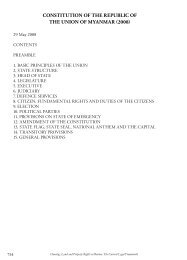Myanmar at the HLP Crossroads: - Displacement Solutions
Myanmar at the HLP Crossroads: - Displacement Solutions
Myanmar at the HLP Crossroads: - Displacement Solutions
You also want an ePaper? Increase the reach of your titles
YUMPU automatically turns print PDFs into web optimized ePapers that Google loves.
<strong>Myanmar</strong> <strong>at</strong> <strong>the</strong> <strong>HLP</strong> <strong>Crossroads</strong> 32The Socialist Military Regime: 1962-1988On 2 March 1962, <strong>the</strong> military, led by General Ne Win, staged a coup d’et<strong>at</strong> overthrowing <strong>the</strong> democr<strong>at</strong>icallyelected Government and establishing a Socialist Revolutionary Council th<strong>at</strong> ruled by decree. The RevolutionaryCouncil launched its own political party, <strong>the</strong> Burma Socialist Programme Party (BSPP), whose membership wasdrawn largely from <strong>the</strong> ranks of <strong>the</strong> military. All democr<strong>at</strong>ic structures including parliament, <strong>the</strong> civil administr<strong>at</strong>ionand <strong>the</strong> judicial system were dismantled and abolished. The 1947 Constitution was not formally repealed,however, <strong>the</strong> dismantling of all major democr<strong>at</strong>ic institutions left many of <strong>the</strong> provisions inoper<strong>at</strong>ive or irrelevant.One of <strong>the</strong> first decrees of <strong>the</strong> Revolutionary Council was th<strong>at</strong> all laws would continue to be in force unless specificallyrepealed.In 1971, <strong>the</strong> BSPP transformed itself into a civilian government. A one party St<strong>at</strong>e was cre<strong>at</strong>ed with no separ<strong>at</strong>ionof powers doctrine. The socialist regime cre<strong>at</strong>ed <strong>the</strong> “People’s Judicial System” with <strong>the</strong> vast majority ofjudges being drawn from <strong>the</strong> ranks of <strong>the</strong> party and having no legal qualific<strong>at</strong>ions. The bar of freelance lawyerswas converted into salaried People’s Attorneys who received <strong>the</strong>ir income from <strong>the</strong> St<strong>at</strong>e. In addition to codifiedlaw, traditional Burmese notions of community, harmony, fair play and socialist concepts were among <strong>the</strong> factorswhich affected court decisions. Fur<strong>the</strong>r, in 1973, <strong>the</strong> Government published a Courts Manual th<strong>at</strong> st<strong>at</strong>ed th<strong>at</strong>judges should not refer to any decisions from o<strong>the</strong>r countries nor earlier decisions of Burma’s courts.In terms of legisl<strong>at</strong>ive tre<strong>at</strong>ment of <strong>HLP</strong> rights during <strong>the</strong> socialist period and acting under <strong>the</strong> slogan “<strong>the</strong>Burmese Way to Socialism”, <strong>the</strong> St<strong>at</strong>e embarked on an expanded programme of large-scale n<strong>at</strong>ionalis<strong>at</strong>ion ofagriculture, building on <strong>the</strong> Land N<strong>at</strong>ionalis<strong>at</strong>ion Act and including <strong>the</strong> n<strong>at</strong>ionalis<strong>at</strong>ion of rice production in 1962.The first <strong>HLP</strong> law approved by <strong>the</strong> new regime, <strong>the</strong> Protection of <strong>the</strong> Right of Cultiv<strong>at</strong>ion Act (1963), st<strong>at</strong>edth<strong>at</strong> <strong>the</strong> following were protected: (1) agricultural land; (2) c<strong>at</strong>tle and ploughing implements; (3) tractors andmachinery; (4) o<strong>the</strong>r implements whe<strong>the</strong>r anim<strong>at</strong>e or inanim<strong>at</strong>e; (5) prohibition from confisc<strong>at</strong>ion for any reasonof agricultural produce and arrest of cultiv<strong>at</strong>ors. It was also stipul<strong>at</strong>ed th<strong>at</strong> such protection would not apply in <strong>the</strong>case of: (a) non-payment of dues owing to <strong>the</strong> st<strong>at</strong>e; (b) disputes arising from inheritance cases or actions takenby <strong>the</strong> st<strong>at</strong>e for security reasons. The Act also empowered <strong>the</strong> St<strong>at</strong>e to confisc<strong>at</strong>e land in lieu of debts, or if “st<strong>at</strong>esecurity” is thre<strong>at</strong>ened.The Tenancy Act (1963) and Tenancy (Amendment) Act (1965) fur<strong>the</strong>r took control of land from agriculturalistsand placed it into <strong>the</strong> hands of <strong>the</strong> st<strong>at</strong>e. (16) The Tenancy Act provided th<strong>at</strong> <strong>the</strong> government may order any landto be leased to tenants, usurping <strong>the</strong> right of landowners to lease <strong>the</strong>ir land. The subsequent Tenancy (Amendment)Act (1965) fur<strong>the</strong>r streng<strong>the</strong>ned <strong>the</strong> hold on land by <strong>the</strong> St<strong>at</strong>e and provided <strong>the</strong> Government with authorityto issue regul<strong>at</strong>ions for tenants working on <strong>the</strong> lands leased from <strong>the</strong> St<strong>at</strong>e. The cultiv<strong>at</strong>ors who, under <strong>the</strong> LandN<strong>at</strong>ionalis<strong>at</strong>ion Act, possessed <strong>the</strong> right to own land now become lessees under <strong>the</strong> laws. Both <strong>the</strong> Land N<strong>at</strong>ionalis<strong>at</strong>ionAct and <strong>the</strong> Tenancy Act empowered <strong>the</strong> st<strong>at</strong>e to determine which crops agriculturalists grow. Noncompliancewith this and o<strong>the</strong>r conditions could result in confisc<strong>at</strong>ion of land, fines and imprisonment.After 12 years in power, <strong>the</strong> socialist military regime approved a new Constitution in 1974. The Constitutionentrenched <strong>the</strong> position of <strong>the</strong> BSPP as <strong>the</strong> only legal political party in <strong>the</strong> country and <strong>the</strong> non-separ<strong>at</strong>ion ofpowers and <strong>the</strong> non-independence of <strong>the</strong> judiciary become constitutionally formalised and complete. As onecomment<strong>at</strong>or has noted, “a monolithic political structure without checks and balances was constitutionalised”. TheConstitution proscribed socialism as <strong>the</strong> official ideology of <strong>the</strong> st<strong>at</strong>e and <strong>the</strong> rights and freedoms granted werecircumscribed by an overriding duty on <strong>the</strong> part of citizens to refrain from undermining: (a) <strong>the</strong> sovereignty andsecurity of <strong>the</strong> st<strong>at</strong>e; (b) <strong>the</strong> essence of <strong>the</strong> socialist system; (c) <strong>the</strong> unity and solidarity of <strong>the</strong> n<strong>at</strong>ional races; (d)peace and tranquillity and (e) public morality.The 1974 Constitution did not explicitly repeal <strong>the</strong> 1947 Constitution, and asserted th<strong>at</strong> existing laws and rules,so long as <strong>the</strong>y were not inconsistent with <strong>the</strong> 1974 Constitution, remained in force until <strong>the</strong>y were repealed oramended by <strong>the</strong> Council of St<strong>at</strong>e. This may be significant as arguably some of <strong>the</strong> provisions of <strong>the</strong> 1947 Constitutionare still in force. One example is compens<strong>at</strong>ion for priv<strong>at</strong>e property th<strong>at</strong> has been expropri<strong>at</strong>ed in <strong>the</strong> public(16) Hudson-Rodd, supra n47.













